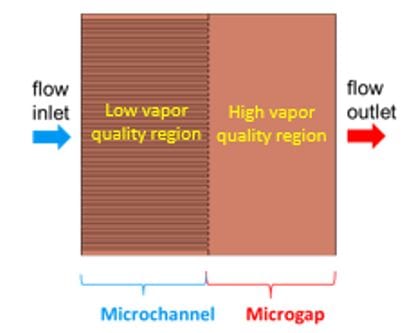Single Phase Transport in Microchannels
|
Although a significant number of studies have been devoted to the investigation of the single phase transport in microchannels, there has been little agreement among different studies. For instance, there is no general agreement as to the applicability of conventional theories in predicting single-phase heat transfer performance in microchannels. The primary goal of this work is to perform careful and systematic experimental investigations into single-phase flow and heat transport in microchannel heat sinks. Comparisons with conventional theory and existing correlations are also made to allow for a critical assessment of their applicability. |
Two Phase Transport in Microchannels
|
Flow boiling in microchannels has attracted a lot of attention in recent years due to its ability to dissipate significantly higher heat fluxes by utilising the latent heat of vaporisation while requiring smaller rates of coolant flow than its single-phase counterpart. Another advantage of the convective boiling process is the greater temperature uniformity across the microchannel heat sinks as the phase-change process takes place at the fluid saturation temperature. In spite of these appealing attributes, the mechanism of convective flow boiling in microchannels is still not well understood and this has impeded their implementation in practical applications. The objective of the present work is to conduct careful and systematic experimental investigation of flow boiling heat transfer and pressure drop in microchannels over a range of channel dimensions, heat fluxes, mass fluxes and fluids. Boiling heat transfer and two-phase pressure drop correlations developed for conventional channels will be critically appraised for their applicability to the prediction of flow boiling behavior in microchannels. In addition, high speed flow visualization will be conducted to explore flow boiling flow and develop flow maps. The coupling of high-speed boiling visualization and temperature and pressure data will allow a better understanding of the different flow boiling mechanisms. Examples of flow boiling are recorded via high-speed camera and are shown in the video clips below. |
|
Video clip courtesy of Tamanna Alam
Copyright Micro Thermal Systems Group |
Video clip courtesy of Tamanna Alam
Copyright Micro Thermal Systems Group |
|
Experiment conditions Observation |
Experiment conditions Observation |
Improving slow boiling stability of microchannel heat sinks
|
Hybrid microchannel-microgap and periodic stepped fin geometric configurations
|
The objective of this research project is to stabilize microchannel flow boiling operation by means of implementing geometric configurations that reduce vapor backflow.
In the first part of this project, a hybrid microchannel-microgap heat sink is developed which consists of a straight microchannel array in the upstream region of the heat sink followed by a microgap channel in the downstream region. The microchannel section operates in the low vapor quality upstream region while the microgap channel operates in the high vapor quality downstream region such that each section operates in the region where it has been demonstrated to offer better two-phase heat transfer performance in prior research. Vapor backflow is mitigated as the increasing flow cross-section area towards the microgap channel promotes forward motion of vapor bubbles and slugs due to the difference in surface tension forces in the upstream and downstream regions. In the second part of the project, a periodic stepped fin microchannel heat sink is developed to stabilize flow boiling by facilitating span-wise vapor bubble expansion at different locations along the flow to limit rapid bi-directional vapor bubble expansion. This heat sink design involves the removal of sections of straight microchannel fins to half their full fin height to create interconnected transverse channels in the upper flow region. Such a configuration provides room to accommodate expanding vapor slugs in the transverse interconnected sections. Unlike other expanding microchannel flow configurations, the available wetted surface area of the periodic stepped fin microchannel is not severely compromised. |





